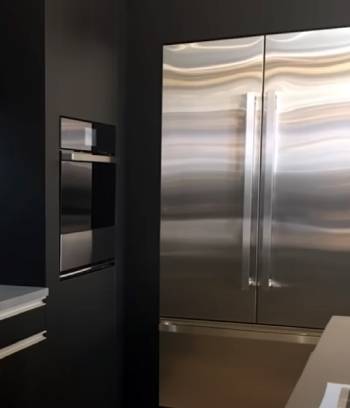Whether you’re planning a kitchen renovation or simply in the market for a new refrigerator, the decision between a counter-depth and a standard-depth fridge is one you’ll need to make.
In this comprehensive article, we’ll explore the key differences between these two types of fridges, the pros and cons of each, and answer some frequently asked questions to help you make the best choice for your home.
A Brief Comparison Table
| Feature | Counter-Depth Fridge | Standard Depth Fridge |
| Appearance | Sleek, seamless look | Bulky, protrudes from counter |
| Space-Saving | Yes, aligns with countertops | No, extends beyond counter |
| Storage Capacity | Limited, less space | Ample, more space |
| Price | Generally more expensive | Generally less expensive |
| Accessibility of Items | Easier access to items | Items may be harder to reach |
| Range of Models and Features | Fewer options | Wider range of options |
Counter-Depth Fridges: Sleek, Stylish, and Space-Saving

Pros of Counter-Depth Fridges
- A Seamless Look
A counter-depth fridge is designed to align with the depth of your kitchen countertops, creating a sleek and seamless look. This design choice can make a significant difference in the overall appearance of your kitchen, providing a high-end and customized feel.
- Space-Saving Design
If you’re working with a smaller kitchen, a counter-depth fridge can be a game-changer. By aligning with the countertops, these fridges save space, making it easier to move around and maximizing your available kitchen real estate.
- Easy Access to Items
With a shallower depth compared to standard fridges, counter-depth models allow for easier access to items stored in the back. This can be a major advantage when you’re in a hurry or searching for a specific ingredient.
Cons of Counter-Depth Fridges
- Limited Storage Capacity
One downside of counter-depth fridges is their reduced storage capacity compared to standard-depth models. This can be a drawback for larger families or those who like to stock up on groceries.
- Higher Price Tag
Typically, counter-depth fridges come with a higher price tag compared to standard-depth models. This is because they are seen as a premium appliance and require more precise manufacturing techniques.
Standard Depth Fridges: Spacious and Budget-Friendly

Pros of Standard Depth Fridges
- Ample Storage Space
If storage capacity is a priority for you, a standard-depth fridge may be the way to go. These fridges offer more space than their counter-depth counterparts, making them a great option for large families or those who like to have plenty of food on hand.
- Budget-Friendly
Standard-depth fridges tend to be more budget-friendly than counter-depth models, which can be a major selling point for many consumers. If you’re looking for a functional fridge without breaking the bank, a standard-depth model could be your best bet.
- Wide Range of Models and Features
With a larger market share, standard-depth fridges come in a wide range of models and features, making it easier to find the perfect fridge for your needs and preferences.
Cons of Standard Depth Fridges
- Bulky Appearance
One of the downsides of standard-depth fridges is their bulky appearance. They often protrude beyond the countertop, which can make your kitchen appear smaller and less streamlined.
- Difficulty Accessing Items
Due to their deeper design, standard-depth fridges can make it more challenging to reach items stored at the back, especially on lower shelves.
FAQs: Frequently Asked Questions
The importance of having a counter-depth refrigerator depends on your personal preferences and priorities. If you value a seamless kitchen design and have limited space, a counter-depth fridge may be the right choice for you. However, if storage capacity is more critical, a standard-depth fridge may be a better option.
Counter-depth fridges are typically more expensive due to their premium design and the more precise manufacturing techniques required to create a slim, streamlined appliance. They are also often viewed as a luxury item, which contributes to their higher price tag.
A counter-depth refrigerator is generally about 25 to 30 inches deep, while a standard-depth fridge is around 30 to 36 inches deep. The exact difference in depth depends on the specific models being compared.
Yes, counter-depth refrigerators are generally more expensive than standard-depth models. This is due to their premium design, manufacturing techniques, and the perception of them as luxury appliances.
The choice between a counter-depth and a standard refrigerator depends on your individual needs, preferences, and budget. If you prioritize a sleek and seamless kitchen design and are willing to pay a premium for it, a counter-depth fridge may be the right choice for you. However, if storage capacity and budget-friendliness are more important, a standard-depth fridge could be a better fit.
The most common refrigerator depth for standard-depth models is around 30 to 36 inches. Counter-depth refrigerators, on the other hand, typically have a depth of 25 to 30 inches. The specific depth of a fridge varies depending on the model and manufacturer.
Wrapping Up: Which Fridge is Right for You?
In conclusion, the choice between a counter-depth and a standard-depth fridge ultimately comes down to your individual needs and preferences. If a seamless, high-end kitchen design and space-saving features are your top priorities, a counter-depth fridge might be the perfect choice. On the other hand, if you’re more concerned with storage capacity and budget-friendliness, a standard-depth fridge could be a better fit.
By carefully considering the pros and cons outlined in this article and taking into account your unique requirements, you’ll be well-equipped to make an informed decision and find the perfect fridge for your home.



